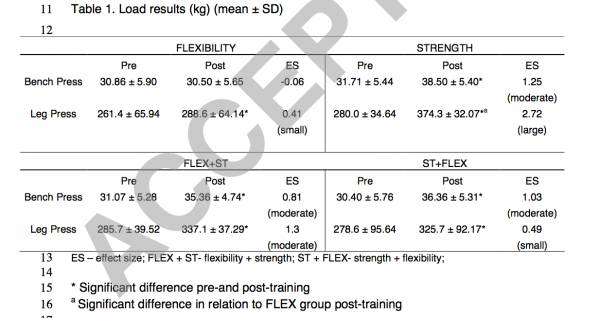Many athletic programs employ dynamic stretching in order to avoid the negative effects of static stretching. However, a recent study in the Journal of Strength and Conditioning Research suggests dynamic stretching might not actually be any better.
What the research says:
- Subjects who did a twelve-week flexibility program got weaker in the bench press.
- Strength training did not seem to negatively affect flexibility.
![]()

Study Design
Dynamic stretching involves more motion than static stretching, so it tends to be a better warm up. The authors of the study used trained individuals who employed dynamic stretching in the same session as a strength workout to mimic many real-life situations. The researchers wanted to see how strength training affected flexibility, since results of previous research have been mixed.
There were 28 female subjects, and each of them was placed in one of four groups:
- Strength training only
- Flexibility training only
- Strength training followed by flexibility training
- Flexibility training followed by strength training
Everyone exercised on alternating days for 48 sessions over the course of twelve weeks. The strength training was comprised of eight compound and isolation exercises, for three sets of 6-12 reps. The flexibility training was all dynamic stretches, meaning each stretch was performed with movement, rather than just held at the end of the range of motion. The participants did dynamic stretches for the whole body, in three sets of thirty reps for each move. It took sixty minutes total to complete the flexibility training session.
The subjects performed two flexibility tests before and after the twelve-week period. They took the standard sit-and-reach test and a test for the goniometry (which is the measure of joint angles) of ten different joints. The subjects also completed two strength assessements at the end of the study, with a ten-rep-max test on both the bench press and leg press.
Results
Bench press strength increased in all of the groups that did strength training, but not in the flexibility-only group. The most significant improvements were, in order:
- Strength-only group
- Strength and flexibility group
- Flexibility and strength group

Table 1 shows how dynamic stretching affected the bench press and leg press in each group.
These results suggest that an hour of dynamic stretching cuts into your strength gains, especially if the stretching is performed first.
Perhaps more surprising, leg press strength increased in all groups, even the flexibility-only group. In fact, as you can see in the table above, the effect strength (ES) of the results in the flexibility-only group was about as large as the strength and flexibility group. The flexibility and strength group actually outperformed both of them, and the strength-only group saw the biggest improvement by far (+207 lbs).
So Did They Get More Flexible?
Flexibility, on the other hand, didn’t improve at all in any of the groups. Perhaps this was due to the fact that the training was performed using dynamic stretches, while the tests were static, but that is not clear. Ultimately, the researchers warned against training any kind of flexibility concurrently with strength training:
For populations desiring maximum strength development, strategic use of flexibility training should be considered to secure the value but avoid the negative effect on strength adaptations.
A few question marks remain, but what is certain is that there was very little improvement in flexibility over the course of the program. And while dynamic stretching may not always work, the good news is that strength training doesn’t seem to have a negative impact on flexibility levels.
References
1. Thalita Leite, et. al., “INFLUENCE OF STRENGTH AND FLEXIBILITY TRAINING, COMBINED OR ISOLATED, ON STRENGTH AND FLEXIBILITY GAINS,” Journal of Strength and Conditioning Research 2014, DOI: 10.1519/JSC.0000000000000719
Photo courtesy of Shutterstock.






